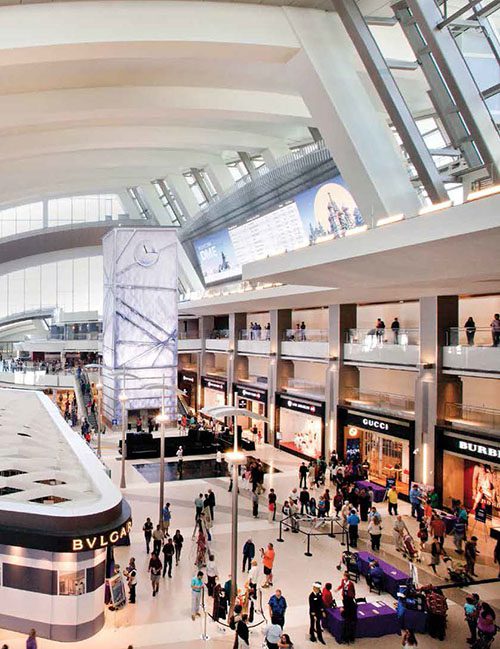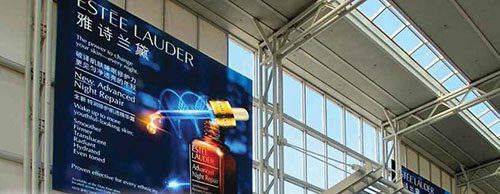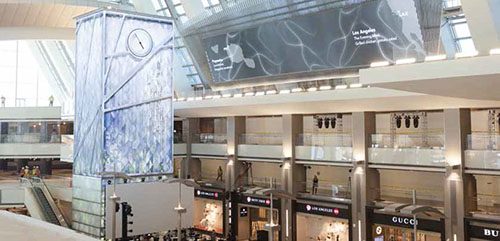 In mid-September, Los Angeles International Airport (LAX) opened the South Concourse and central core of the New Tom Bradley International Terminal (TBIT). With an overall budget of $1.9 billion, the project is part of a $4.1 billion capital improvements program that is the largest public works project in the history of Los Angeles.
In mid-September, Los Angeles International Airport (LAX) opened the South Concourse and central core of the New Tom Bradley International Terminal (TBIT). With an overall budget of $1.9 billion, the project is part of a $4.1 billion capital improvements program that is the largest public works project in the history of Los Angeles.
"We set out to reestablish LAX as the premier international gateway, and I think we actually achieved that," says Roger Johnson, deputy executive director for Los Angeles World Airports (LAWA).
Increasing gate capacity for larger, new-generation aircraft such as the Airbus 380 and Boeing 747-8 Intercontinental was a key component of the project. Nine new boarding gates on the west side of the terminal – each with three loading bridges – will do just that. When the new terminal is complete, LAX will have the most A380-capable gates of any airport in the United States, Johnson notes.Phase I of the new TBIT project, which broke ground in February 2010 and encompasses the north and south concourses, will add nearly 1.2 million square feet to the existing TBIT when completed in 2015. The great hall, named the Antonio Villaraigosa Pavilion after the city's mayor, features 150,000 square feet of concessions and other passenger amenities and was designed to be a tremendous upgrade from the terminal's previous offerings.
 factsfigures factsfigures
Project: Terminal Redevelopment/Expansion Location: Los Angeles Int'l Airport Specific Area: Tom Bradley Int'l Terminal Owner: Los Angeles World Airports Construction: Joint Venture of Walsh Construction Co. & Austin Commercial Architect: Fentress Architects/HNTB Program/Construction Mgt: Parsons, CH2MHill, AECOM, Jacobs, Arcadis, Vanir KDG Integrated Media System: MRA Int'l Video Displays: Daktronics Visual Docking Guidance Systems: Safegate Airport Systems Terminal Seating: Arconas Retractable Stanchions: Visiontron |
LAX is one of the primary target markets for the A380, he explains. "We really needed facilities capable of accommodating the new, large aircraft," he states.
Competitively speaking, LAX could not afford to lose passenger traffic to other airports, says Michael Doucette, LAWA project manager. The value of a wide-body aircraft – whether the Boeing 747 or A380 – flying daily into LAX throughout the year is worth $600 million to the local economy, he notes.
"We need to remain competitive," Johnson says.
Meeting Demand
Last year, more than 30 airlines served 8.6 million international travelers at TBIT – about half of LAX's overall international passenger volume. The new TBIT will have a total of 18 new boarding gates, including the nine that can accommodate wide-bodies. 
Overall, the airport has been growing "fairly steadily" at about 3.5% per year, with international volume up nearly 6%, Johnson reports. Because of the international growth, the airport could not afford to work on both of the old concourses at the same time as originally scheduled, Doucette notes. "We need to carefully balance how many gates we close at a time or how many we can bring on line at a time," he explains, acknowledging that the approach lengthens the program's overall timetable.
TBIT was originally constructed in 1984. And, while it has received some facelifts through the years, it has never provided "what any of us would consider to be an acceptable level of service for passengers," explains Johnson.
Changes in security requirements after 9/11 contributed to the terminal's shortcomings, but the facilities were "simply undersized and designed for a different type of operation," Doucette relates.
TBIT was originally designed as a bus gate facility, where the concourse would simply provide check-in and ticketing services before passengers were bussed to a remote gate. But that plan changed during construction, and the building has never been "appropriately sized for the throughput at LAX," Johnson notes.
Improved Customer Experience
Dan Simich, a senior project manager with Parsons, says the newly opened terminal allows LAX to provide a good travel experience and accommodate passengers, aircraft and baggage efficiently and safely. (Parsons is one member of the integrated program management team for the project.)
The ability to board and deplane passengers more rapidly is not only a tremendous benefit for passengers and airlines alike, it is also a competitive issue, notes Doucette. "They can turn that plane much faster here in a shorter amount of time and get it back in the air again," he explains.
Boarding at the A380-capable gates is expedited by gate ticket readers that allow passengers to board in four lanes. Outside the terminal, ramp information display systems and advanced visual guidance docking systems at the gates also improve the process, adds Doucette.
Immigration and Customs have also been upgraded significantly, including the addition of self-check-in kiosks in the primary inspection area. The former Customs and Immigration area, which had a practical capacity of roughly 2,500 passengers per hour, was undersized from the beginning, Doucette relates. The new facility is designed to process about 4,500 passengers per hour and grew from 12 contact gates to 18. The average gate size was also "significantly expanded."
Gate areas and other sections of the terminal are outfitted with new seating from Arconas. Many of the styles selected exhibit design influences from the hospitality industry, and fully 60% of the seats include power and data ports. Some also contain footrests and cup holders, which are already proving popular with airport visitors.
Visitor Centric
The terminal is designed to improve the passenger experience and ensure LAX's status as a gateway to America and the world, says Curtis Fentress, designer of the new terminal and chairman of Fentress Architects.
The design was largely influenced by local citizens, notes Johnson. Focus groups yielded about 5,000 words to describe the city, which planners then distilled into five dominant themes: media, the future, diversity, change and the environment. The mayor of Los Angeles ultimately selected the environment as the primary design concept.
"People come to L.A. because of the environment, the sunny days and the beach," describes Fentress. Inspired by the local environment, the roof of the new terminal recalls waves rolling onto a beach. Functionally, the roof design shields the western and southern sun, while allowing in daylight from the east and north. "Dramatic clerestories bring lots of daylight into the space and the underside of the wave, the curl of the waves, is the ceiling which bounces the light down into the space," he explains. "It's a very dramatic and unique space."
Inside the concourses, ceiling heights generally range from 40 to 60 feet. In the great hall, which was designed to resemble an old-world piazza, the ceiling soars to 100 feet and a terrace-like structure creates an open-air feel. The area plays up the design concept of the Southern California environment, notes Doucette. Bottom to the top, the great hall is almost 150 feet tall, and roughly the size of four football fields.
Overall, the new TBIT includes 1.3 million square feet of new construction, with six levels in the main core and three and one-half concourse levels.
Construction Challenges
The open design of the steel-frame building provided some construction challenges, Johnson notes. Specifically, the welded connections between the roof trusses and the building supports are not right angles – a first for any building in Los Angeles. To reassure the city building department that the structure met its design calculations, the airport built and stressed sample connections inside a structural engineering lab at the University of California-San Diego.
The process was performed more than once, because the sample connections didn't pass the test the first time. "So we learned something out of it, in terms of how the connections went together, and made some slight modifications to the way the beams were shaped near the connections, retested them and were able to strike the building significantly and increase the failure points through that testing," Doucette recalls.
At the same time, LAX undertook nearly $700 million in airfield improvements. During the peak of construction, the airport was putting about $4 million of work in place on a daily basis, recalls Johnson. With more than 4,000 contractor employees working on the airfield, getting workers and materials to the secure site was a formidable logistics challenge.
"This site sat between four active runways and within 100 feet of an active taxiway for a period of time," Doucette explains. "It was completely landlocked inside the secure area of the terminal building. So 100% of materials, activity and workers needed to be transported across an active airfield to this location."
Impact to passengers, however, has been nominal, because 90% of the work was new construction immediately adjacent to the existing terminal. Parsons, which was also on board during the terminal's last update in 2006, worked to make phasing as smooth as possible, says Russell Carlisle, the firm's design manager for the project.
 Sustainability
Sustainability
The new TBIT is designed to achieve silver certification for Leadership in Energy and Environmental Design (LEED). In addition to using recycled materials, high-performance window glazing and natural daylighting, architects designed the roof forms to optimize the sun's warmth during cooler months and reflect it during warmer months. While LAX is close to qualifying for gold LEED status, Doucette says the airport was "more interested in the sustainability of the building than achieving a particular label."
LAX requires any construction equipment that will be on-site for more than 21 days to meet or exceed emissions requirements from the California Air Resources Board for on-road vehicles, Johnson notes. While not required by law, the airport insists that equipment be fitted with pollution control equipment, which results in a "significant reduction in diesel particulates, carbon monoxide and other greenhouse and criteria pollutant emissions," he explains.
Looking Ahead
Phase II of the TBIT project will include new boarding bridges and aircraft aprons on the east side of the new terminal; upgrades to Customs and Immigration inspection areas; relocation and upgrading of the federal passenger security screening area; public art installations; secured corridors between Terminal 3, TBIT and Terminal 4; and demolition of the existing terminal's east side gates.
 Upcoming work will also include a consolidated passenger security checkpoint. Currently, TBIT has 12 lanes, divided evenly between the south and north entrances. During Phase II, they will be consolidated into a single, 20-lane checkpoint located on what is now the mezzanine level of the existing TBIT.
Upcoming work will also include a consolidated passenger security checkpoint. Currently, TBIT has 12 lanes, divided evenly between the south and north entrances. During Phase II, they will be consolidated into a single, 20-lane checkpoint located on what is now the mezzanine level of the existing TBIT.
In addition to increasing throughput, the new checkpoint will also improve the overall passenger experience. "We're taking them out of what are essentially some low-overhead, dark areas and we're putting them under skylights," Johnson explains.
The $4.1 billion capital improvement program at LAX has had an impact of $7 billion on the region and created some 40,000 jobs, directly and indirectly. And, with the expanded concessions program, more than 1,000 more jobs have been created at the airport.

|
Move Over IMAX Huge electronic signage installations running original video content and arrival/departure information are a prominent feature in the new Tom Bradley International Terminal (TBIT) at Los Angeles International Airport (LAX). Collectively, the airport refers to the seven large media features as its Integrated Environmental Media System. On the equipment side, the $50 million system includes more than 12,000 square feet of light emitting diode (LED) tiles, hundreds of liquid crystal display (LCD) screens and a dedicated control and content management network system. In total, it includes nearly 9,600 square feet of active displays with an output of more than 105 million pixels – eight times an IMAX theater, note airport officials. The displays run roughly 60 ultra-high resolution multimedia productions, totaling more than four hours of original content. The system was designed to enhance the passenger experience as well as provide a revenue source through sponsorship opportunities, explains Michael Doucette, project manager at LAX. "These video displays were put in to enhance the [passenger] experience and to bring back the romance of travel," Doucette says. Content ranges from colorful, modern images about the Los Angeles area to a retro black-and-white tribute to Hollywood musicals to short pieces about various destinations of LAX airlines. "It's not advertising," notes Roger Johnson, LAWA's deputy executive director. "We're not trying to make LAX Times Square, Tokyo or the Vegas Strip." The Bon Voyage Wall, a framed 30-foot-by-50-foot display located after the security checkpoint and before the departure gates, runs slow motion videos of people jumping – "whimsical, enjoy-your trip" content is how Johnson describes it. Standing 72 feet tall, the Time Tower displays video content on all four sides of a two-bay elevator column. With 5,480 square feet of LED surfaces, a clock at the top and interactive features at the base, the tower is the visual centerpiece of the new digital system, and the great hall in general. The elevator doors are the only part of its surface not covered with screens. The Story Board, also inside the great hall, stretches for 120 feet, displaying images that highlight Los Angeles' connection to the movies, music, comic books and graphic arts. LED screens arranged in a mosaic pattern showcase destination-based content. "It doesn't focus on things like significant landmarks or the traditional images," Johnson explains. "It's more the day-to-day life and shows the culture of a departure city." Large blade panels on both sides of the great hall heading to the concourse are known as the departure portals; and new flight information displays span 75 feet long and 15 feet tall. Despite all of the system's cutting-edge features, LAX is working to make it even more impressive, with an application that will allow passengers to interact with the entertainment content or interface with the concessions program from their handheld devices, notes Doucette. Architect Curt Fentress allowed the airport to turn elements of its new digital media system into architectural features, as opposed to just hanging screens on walls, Doucette notes. "Curt embraced what we were trying to do and worked with Mike Rubin and Associates to come up with ideas that actually enhanced the architecture of the building," Johnson adds. LAX's integrated media system project was directed by Mike Rubin and Associates International and designed by Sardi Design. Daktronics supplied and installed $20 million of displays, and supported the system with an extensive fiber optic backbone, a dedicated power supply, dedicated HVAC and fire protection systems and an equipment/control room.
The content management system was designed by Smart Monkeys Inc., and Electrosonic Inc. provided systems engineering and integration. Moment Factory and Digital Kitchen produced the content. |



